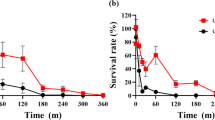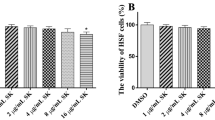Abstract
The increasing infection and drug resistance frequency has encouraged the exploration of new and effective anti-Candida albicans agents. In this study, CT-K3K7, a scorpion antimicrobial peptide derivative, effectively inhibit the growth of C. albicans. CT-K3K7 killed C. albicans cells in a dose-dependent manner, mainly by damaging the plasma membrane. CT-K3K7 could also disrupt the nucleus and interact with nucleic acid. Moreover, CT-K3K7 induced C. albicans cells necrosis via a reactive oxygen species (ROS)-related pathway. Furthermore, CT-K3K7 inhibited the hyphal and biofilm formation of C. albicans. In the mouse skin subcutaneous infection model, CT-K3K7 significantly prevented skin abscess formation and reduced the number of C. albicans cells recovered from the infection area. Taken together, CT-K3K7 has the potential to be a therapeutic for C. albicans skin infections.







Similar content being viewed by others
Data Availability
No datasets were generated or analysed during the current study.
References
Kashem SW, Kaplan DH (2016) Skin immunity to Candida albicans. Trends Immunol 37(7):440–450. https://doi.org/10.1016/j.it.2016.04.007
Mayer FL, Wilson D, Hube B (2013) Candida albicans pathogenicity mechanisms. Virulence 4(2):119–128. https://doi.org/10.4161/viru.22913
Wagener J, MacCallum DM, Brown GD et al (2017) Candida albicans chitin increases arginase-1 activity in human macrophages, with an impact on macrophage antimicrobial functions. mBio 8(1). https://doi.org/10.1128/mBio.01820-16
Radhakrishnan VS, Reddy Mudiam MK, Kumar M et al (2018) Silver nanoparticles induced alterations in multiple cellular targets, which are critical for drug susceptibilities and pathogenicity in fungal pathogen (Candida albicans). Int J Nanomedicine 13:2647–2663. https://doi.org/10.2147/IJN.S150648
Gregor JB, Gutierrez-Schultz VA, Hoda S et al (2023) An expanded toolkit of drug resistance cassettes for Candida glabrata, Candida auris, and Candida albicans leads to new insights into the ergosterol pathway. mSphere e0031123. https://doi.org/10.1128/msphere.00311-23
Sowers A, Wang G, Xing M et al (2023) Advances in antimicrobial peptide discovery via machine learning and delivery via nanotechnology. Microorganisms 11(5). https://doi.org/10.3390/microorganisms11051129
Yeaman MR, Yount NY (2003) Mechanisms of antimicrobial peptide action and resistance. Pharmacol Rev 55(1):27–55. https://doi.org/10.1124/pr.55.1.2
Svenson J, Molchanova N, Schroeder CI (2022) Antimicrobial peptide mimics for clinical use: Does size matter? Front Immunol 13:915368. https://doi.org/10.3389/fimmu.2022.915368
Amorim-Carmo B, Parente AMS, Souza ES et al (2022) Antimicrobial peptide analogs from scorpions: Modifications and structure-activity. Front Mol Biosci 9:887763. https://doi.org/10.3389/fmolb.2022.887763
Lourenco ALP, Rios TB, da Silva AP et al (2023) Peptide stapling applied to antimicrobial peptides. Antibiotics (Basel) 12(9). https://doi.org/10.3390/antibiotics12091400
Li S, Shui Y, Ma J et al (2022) Antimicrobial activity of CT-K3K7, a modified peptide by lysine substitutions from ctry2459 - a Chaerilus tryznai scorpion venom peptide. Toxicon 218:88–98. https://doi.org/10.1016/j.toxicon.2022.09.004
CLSI (2019) Performance Standards for Antimicrobial Susceptibility Testing. CLSI document M100, 29th ed (ISBN 978-1-68440-032-4). https://clsi.org/
Li Z, Jing X, Yuan Y et al (2022) In vitro and in vivo activity of Phibilin against Candida albicans. Front Microbiol 13:862834. https://doi.org/10.3389/fmicb.2022.862834
Wang Q, Xu Y, Dong M et al (2018) Hjh-1, a broad-spectrum antimicrobial activity and low cytotoxicity antimicrobial peptide. Molecules 23(8). https://doi.org/10.3390/molecules23082026
Maurya IK, Thota CK, Sharma J et al (1830) (2013) Mechanism of action of novel synthetic dodecapeptides against Candida albicans. Biochim Biophys Acta 11:5193–5203. https://doi.org/10.1016/j.bbagen.2013.07.016
Jia C, Zhang J, Yu L et al (2018) Antifungal activity of coumarin against Candida albicans is related to apoptosis. Front Cell Infect Microbiol 8:445. https://doi.org/10.3389/fcimb.2018.00445
Yang LF, Liu X, Lv LL et al (2018) Dracorhodin perchlorate inhibits biofilm formation and virulence factors of Candida albicans. J Mycol Med 28(1):36–44. https://doi.org/10.1016/j.mycmed.2017.12.011
Scarsini M, Tomasinsig L, Arzese A et al (2015) Antifungal activity of cathelicidin peptides against planktonic and biofilm cultures of Candida species isolated from vaginal infections. Peptides 71:211–221. https://doi.org/10.1016/j.peptides.2015.07.023
Garcia A, Fan YY, Vellanki S et al (2019) Nanoemulsion as an effective treatment against human-pathogenic fungi. mSphere 4(6). https://doi.org/10.1128/mSphere.00729-19
Buda De Cesare G, Cristy SA, Garsin DA et al (2020) Antimicrobial peptides: A new frontier in antifungal therapy. mBio 11(6). https://doi.org/10.1128/mBio.02123-20
do Nascimento Dias J, de de Souza Silva C, de Araujo AR et al (2020) Mechanisms of action of antimicrobial peptides toap2 and ndbp-5.7 against Candida albicans planktonic and biofilm cells. Sci Rep 10(1):10327. https://doi.org/10.1038/s41598-020-67041-2
Jayasinghe JNC, Whang I, De Zoysa M (2023) Antifungal efficacy of antimicrobial peptide Octominin II against Candida albicans. Int J Mol Sci 24(18). https://doi.org/10.3390/ijms241814053
Nguyen LT, Haney EF, Vogel HJ (2011) The expanding scope of antimicrobial peptide structures and their modes of action. Trends Biotechnol 29(9):464–472. https://doi.org/10.1016/j.tibtech.2011.05.001
Fjell CD, Hiss JA, Hancock RE et al (2011) Designing antimicrobial peptides: Form follows function. Nat Rev Drug Discov 11(1):37–51. https://doi.org/10.1038/nrd3591
Vrablikova A, Czernekova L, Cahlikova R et al (2017) Lasioglossins LLIII affect the morphogenesis of Candida albicans and reduces the duration of experimental vaginal candidiasis in mice. Microbiol Immunol 61(11):474–481. https://doi.org/10.1111/1348-0421.12538
Zhang LJ, Gallo RL (2016) Antimicrobial peptides. Curr Biol 26(1):R14–R19. https://doi.org/10.1016/j.cub.2015.11.017
Li L, Sun J, Xia S et al (2016) Mechanism of antifungal activity of antimicrobial peptide app, a cell-penetrating peptide derivative, against Candida albicans: Intracellular DNA binding and cell cycle arrest. Appl Microbiol Biotechnol 100(7):3245–3253. https://doi.org/10.1007/s00253-015-7265-y
Villalpando-Rodriguez GE, Gibson SB (2021) Reactive oxygen species (ROS) regulates different types of cell death by acting as a rheostat. Oxid Med Cell Longev 2021:9912436. https://doi.org/10.1155/2021/9912436
Belenky P, Camacho D, Collins JJ (2013) Fungicidal drugs induce a common oxidative-damage cellular death pathway. Cell Rep 3(2):350–358. https://doi.org/10.1016/j.celrep.2012.12.021
Hwang JH, Hwang IS, Liu QH et al (2012) (+)-Medioresinol leads to intracellular ROS accumulation and mitochondria-mediated apoptotic cell death in Candida albicans. Biochimie 94(8):1784–1793. https://doi.org/10.1016/j.biochi.2012.04.010
Atriwal T, Chawla M, Hussain A et al (2021) Reactive oxygen mediated apoptosis as a therapeutic approach against opportunistic Candida albicans. Adv Protein Chem Struct Biol 125:25–49. https://doi.org/10.1016/bs.apcsb.2020.12.004
Cho J (1810) Lee DG (2011) The antimicrobial peptide arenicin-1 promotes generation of reactive oxygen species and induction of apoptosis. Biochim Biophys Acta 12:1246–1251. https://doi.org/10.1016/j.bbagen.2011.08.011
Hwang B, Hwang JS, Lee J et al (2011) Induction of yeast apoptosis by an antimicrobial peptide. Papiliocin Biochem Biophys Res Commun 408(1):89–93. https://doi.org/10.1016/j.bbrc.2011.03.125
Park C, Lee DG (2010) Melittin induces apoptotic features in Candida albicans. Biochem Biophys Res Commun 394(1):170–172. https://doi.org/10.1016/j.bbrc.2010.02.138
Ma H, Yang L, Tian Z et al (2023) Antimicrobial peptide AMP-17 exerts anti-Candida albicans effects through Ros-mediated apoptosis and necrosis. Int Microbiol 26(1):81–90. https://doi.org/10.1007/s10123-022-00274-5
Whiteway M, Bachewich C (2007) Morphogenesis in Candida albicans. Annu Rev Microbiol 61:529–553. https://doi.org/10.1146/annurev.micro.61.080706.093341
Khan F, Bamunuarachchi NI, Tabassum N et al (2021) Suppression of hyphal formation and virulence of Candida albicans by natural and synthetic compounds. Biofouling 37(6):626–655. https://doi.org/10.1080/08927014.2021.1948538
Abirami G, Alexpandi R, Durgadevi R et al (2020) Inhibitory effect of morin against Candida albicans pathogenicity and virulence factor production: An in vitro and in vivo approaches. Front Microbiol 11:561298. https://doi.org/10.3389/fmicb.2020.561298
Funding
This research was funded by the Key Specialized Research and Development Breakthrough in Henan Province (grant no: 232102310197).
Author information
Authors and Affiliations
Contributions
ZL, HW, and SL: Methodology, Investigation. ZL, YS, HW, SL, BD, and WZ: Validation, Formal analysis, Data curation. ZL and WZ: Writing – review & editing. WZ: Funding acquisition. SG and LZ: Supervision, Resources. All authors read and approved the manuscript.
Corresponding authors
Ethics declarations
Ethical Statement
All the animal associated experiments were conducted following the Animal Care Ethics guidelines with protocols approved by the Animal Care and Use Committee of Henan University of Technology and Science. The mice were humanely euthanized (anesthetized by intra-peritoneal pentobarbital injection and sacrificed by cervical dislocation) at the end of the experiments.
Competing Interests
The authors declare no competing interests.
Additional information
Publisher's Note
Springer Nature remains neutral with regard to jurisdictional claims in published maps and institutional affiliations.
Rights and permissions
Springer Nature or its licensor (e.g. a society or other partner) holds exclusive rights to this article under a publishing agreement with the author(s) or other rightsholder(s); author self-archiving of the accepted manuscript version of this article is solely governed by the terms of such publishing agreement and applicable law.
About this article
Cite this article
Li, Z., Shui, Y., Wang, H. et al. In Vitro and In Vivo Anti-Candida albicans Activity of a Scorpion-Derived Peptide. Probiotics & Antimicro. Prot. (2024). https://doi.org/10.1007/s12602-024-10233-3
Accepted:
Published:
DOI: https://doi.org/10.1007/s12602-024-10233-3




